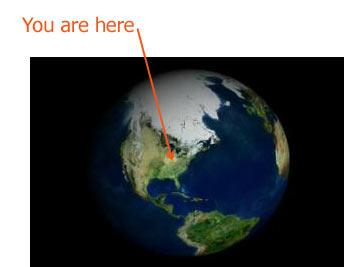 In
the early days of the web, (pre-scroll wheel) it was estimated that 90% of
people never scrolled down.
In
the early days of the web, (pre-scroll wheel) it was estimated that 90% of
people never scrolled down. In
the early days of the web, (pre-scroll wheel) it was estimated that 90% of
people never scrolled down.
In
the early days of the web, (pre-scroll wheel) it was estimated that 90% of
people never scrolled down.
Horizontal scrolling is still awkward.
Put as much navigation as possible, and absolutely essential information within
the prime screen real-estate: the part of the page that displays initially
when someone visits your site-- an area of approximately ?? pixels.
Which of these sites communicates what the
site is about 'above the fold'? At what widths do these sites still look "acceptable"?
Access speed to someone else's web page is controlled not only by the speed of your computer's modem or network connection, but the rest of the internet in between.
Useability studies indicate that:
You have a few seconds to grab the attention of the least-committed
visitors to your site, and this is enough time to show ca. 100 kB.
...In other words, some of us all the time, all of us some of the time.
Strategies for designing for those with a slow Internet connection include:
"A uniform format for organizing and presenting your information allows users to apply their past experience with your site to future searches and explorations, and allows users to predict how an unfamiliar section of your Web site will be organized."
Yale C/AIMMFrames are tempting as a way of keeping all your navigational apparatus in one place, even with many pages. But, don't use'em if it's possible that other authors may want to construct links into some sub-page of your site, rather than just the top.

Even pre-web books use cues to let you locate yourself.
These become more important when a page is taken out of context (for example, photocopied).

Visitors might arrive in the middle of your site, never having seen your home page when they
This GC SST update (Nicaragua),
and a page on navigation from
Nielsen's "Use-it" website both use a "breadcrumb
trail" at the top of the page.
This page within
the Washington Post highlights the current page location in their navigation
bar.
Site design themes
Training, Teaching, Continuing Education, Reference, Entertainment, News, E-commerce
p 47-53
Home page strategies
menu, news, path-based, splash screen, hybrid/combination Elements to include in a site menus/subsites resource lists/other related sites what's new search contact info maps, parking FAQ customer service error pages site guides table of contents/site indexes site map p 55-75
Photo credit: newspaper machine.